ISE researcher Holly Hussein looks into how student employers attracted new and diverse talent to their programmes in 2021.
Successful student recruitment is dependent on effective marketing and attraction. Employers need activities that put their organisation on students’ radars, pique the interest of potential applicants and encourage applications from a wide range of candidates.
We delve into this year’s Student Recruitment Survey to find out how and when employers have attracted and engaged students during the last academic year and which activities were effective.
Virtual marketing and attraction activities
Recruitment campaigns tend to follow the academic year, starting in the autumn and ending in the spring/summer.
Survey responses this year indicated that the application process for school and college leavers can be longer than for graduates, often still making offers between April and June and closing between July and September.
In 2020/2021, almost all (94%) marketing and attraction activities took place online. Organisations mainly ran virtual talks, careers fairs and open days as opposed to returning to campuses in person.
The activities claimed to be most effective were job adverts, giving talks and workshops, careers fairs and social media marketing – which were all also the most commonly used techniques.
Connecting with educational organisations helps companies gain access to students in order to deliver attraction events.
The average employer worked with 49 schools and sixth forms, 7 further education colleges and 28 universities.
Organisations’ use of marketing and attraction activities

Diversity
Despite efforts to tackle inequality, there are still certain groups that are severely under-represented on early career talent programmes. Therefore, when choosing which attraction events to run and where, it is essential to consider how these will help to create a diverse workforce.
The majority (65%) of employers have formal diversity benchmarks in place, with several more explaining that they don’t have any specific targets but improving diversity is a priority within their business.
The diversity strands that the largest proportion of organisations had benchmarks for were gender, ethnicity and socio-economic background, which echoes the results of last year’s survey. Progress is required to ensure action is taken to address the less targeted diversity strands.
Proportion of organisations with targets for attracting diverse hires

Attraction techniques can be altered to reach a larger number of students from a wider range of backgrounds, so that applications are received from a more diverse pool of candidates.
The most popular techniques to achieve this are by actively targeting particular groups, changing the universities visited and tailoring marketing materials to engage specific diversity groups.
Action taken by employers to attract more diverse candidates

While there is already a lot of activity in the diversity and inclusion space, more action is needed – almost all respondents highlighted at least one diversity strand that they still need to work on within the next five years.


0 Comments